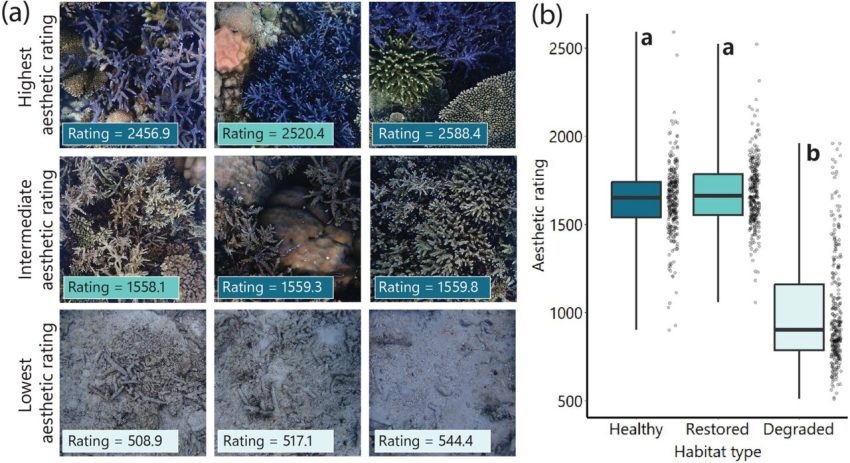The Importance of Coral Reefs and Their Aesthetic Value
Coral reefs are more than just underwater landscapes—they are vibrant ecosystems that play a crucial role in the health of our oceans. But why do people care so much about them? What makes their destruction such a source of concern and outrage? And what motivates individuals and communities to go to great lengths to protect and restore these delicate environments?
The answer lies in a combination of ecological, economic, and aesthetic factors. Healthy coral reefs are among the most visually stunning ecosystems on Earth, and this beauty is far from superficial. It has deep cultural significance, supports thriving tourism industries, and fosters a sense of connection to the ocean. People often feel an emotional bond with coral reefs, which drives efforts to preserve them.
But how can something as intangible as “beauty” be measured? And when reefs are damaged, can they be rebuilt in a way that restores not just their ecological function, but also their visual appeal?
Measuring Beauty in Coral Reefs
Traditionally, many coral reef monitoring and restoration programs have overlooked the aesthetic value of reefs, considering it too subjective to quantify. However, for scientists, this was a challenge worth addressing. To effectively engage people in conservation, it was essential to find a way to measure and understand the beauty of coral reefs.
A recent study published in Scientific Reports tackled this issue head-on. The research team developed a method to quantify the aesthetic value of coral reefs and track their recovery after damage. This approach could be a game-changer in how we assess the success of reef restoration projects.
One of the key locations for this research is the Mars Coral Restoration Program in central Indonesia. This initiative, the largest of its kind, has brought together local communities and international businesses to rebuild reefs that were once destroyed by dynamite fishing. This illegal practice uses explosives to stun and kill fish, but it also shatters coral into rubble, wiping out entire reef systems in seconds.
Restoring Visual Appeal
The Mars program has already seen success in regrowing coral reefs. But the researchers wanted to know if these restored reefs could recreate the visual appeal of natural ones. To find out, they took standardized underwater photos using settings that automatically adjust white balance and color to account for light conditions. This allowed them to capture accurate images across healthy, degraded, and restored sites.
They then conducted online surveys with over 3,000 participants, asking them to compare pairs of photos and choose which one they found more beautiful. The results showed that people from diverse backgrounds consistently agreed on what made a reef beautiful. Factors like high coral cover, vibrant colors, and complex structures were universally favored.
This suggests there is a shared human appreciation for the beauty of thriving reefs, regardless of age, nationality, or familiarity with the ocean. Even those without direct experience with coral reefs tended to prefer images with rich biodiversity and visual complexity.
Using AI to Predict Beauty
The researchers also used the survey data to train a machine-learning algorithm to predict people’s preferences for different coral habitats. The results from the algorithm matched the human responses, showing that restored reefs were rated just as beautiful as healthy ones. In contrast, degraded reefs—marked by gray rubble and little life—were consistently rated lower.
This is encouraging news for reef restoration efforts. It shows that rebuilding damaged reefs can bring back the beauty that makes them so valuable. Moreover, it highlights the potential for using simple photo-based monitoring to track reef recovery over time.
Tracking Recovery Through Aesthetics
The study found that beauty is strongly linked to factors like the number of colors present, the proportion of living coral, and the complexity of coral structures. On the other hand, areas dominated by dead coral and rubble were ranked lowest in terms of aesthetic value.
These findings suggest that promoting a variety of coral colors and shapes can help both marine life and the visual appeal of reefs. Restoration experts can achieve this by selecting donor corals—healthy corals transplanted to degraded sites—to add color and diversity to recovering reefs.
Long-Term Care and Sustainable Practices
Coral reefs require long-term care to survive and thrive. Initial restoration efforts must be paired with ongoing monitoring and maintenance to ensure that gains are not lost. Additionally, any tourism development around restored reefs should be managed sustainably to avoid further damage.
Restoration and sustainable tourism practices can help protect the ecological and social benefits of healthy, beautiful reefs. For communities that rely on marine tourism, restoring these ecosystems is essential. It also plays a vital role in inspiring people to care for the ocean and its fragile inhabitants.
Ultimately, the ability to measure and restore the beauty of coral reefs is a powerful tool in the fight to protect these invaluable ecosystems.
